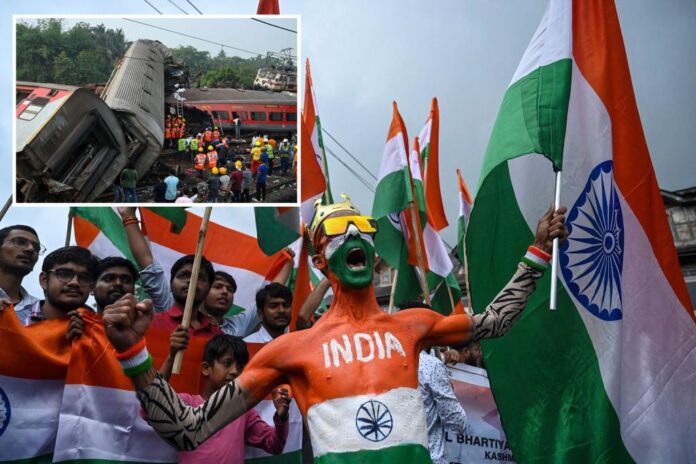India’s GDP grew by more than 7% last year, its tech unicorns have dazzled the world, and electronic payment transactions have surged across the country. And now, with 1.4 billion people – India’s population has surpassed China’s, suggesting to many that a “demographic dividend” of young Indians could power an economic boom.
It’s “India’s moment,” say much of the nation’s elite in tandem with many global political leaders, especially in the US. But this thinking is economically and geopolitically shortsighted for a nation now marking its 75th anniversary.
A story is told of a drunken man looking for lost keys under a lamppost. Asked why he was searching there, he answers, “That is where the light is.” A similar “out-of-sight” ethos now courses through India, whose economy and people are in the midst of a slow-moving assault that has wounded vast numbers and threatens many more. This is indeed a “moment” for India, but one of growing economic and moral crisis rather than triumph and jubilation.
The high-GDP growth trope is wishful thinking clothed in juvenile economics. In the unkind terminology of economic forecasters, the Indian economy has experienced a dead-cat bounce – a short-lived recovery from the deep decline endured by a pair of COVID waves. Over the past four years, India’s GDP has increased overall at an annual 3.5% rate, an abysmal pace for a poor country and a far cry from the heady 6-7% predicted by the Asian Development Bank over the coming years.
India’s central problem lies with a severe jobs shortage. Take the nation’s railways, back in the news following a crash that killed hundreds earlier this month. In 2019, 12.5 million people applied for 35,000 job openings in the Indian railways. In January 2022, the railway authorities announced that they were still not yet ready to make the promised job offers. The applicants went on a rampage, burning train cars and vandalizing railway stations. Such desperation is a daily staple but rarely newsworthy.
India’s jobs shortfall is best measured by its “surplus labor,” a concept much broader than the standard “unemployment rates.” Quite simply, most Indians cannot afford to not work. So, multiple people (often within an extended family) enter into work-sharing arrangements to the jobs of a single person—in agriculture, petty manufacturing, retail trade, and myriad services. Paltry incomes are better than nothing. These work-sharers are vast in number but meager in impact: Remove them from the workforce and overall economic output will remain unchanged.
India has more than 1 billion working-age people 15 years or older. Of these, 560 million are in the workforce; and of those, at least 100 million are surplus. Millions more, meanwhile, have dropped out of the labor statistics entirely.

Those lucky enough to find full-time work often fall into the trap of long, unforgiving working hours in inhumane conditions. They exist just a job-loss or illness away from disaster. Only about 10% of Indian workers receive a weekly or monthly paycheck with at least one social security benefit.

Unlike East Asian leaders, who educated their citizens and channeled them into labor-intensive manufacturing for exports, Indian leaders sold slogans and hawked illusions of tech-based job solutions. Narendra Modi’s government—in power for nine years—has had a worse job-creation record than many of its predecessors. Rather than benefiting from a “demographic dividend,” young aspirants will simply enlarge the existing pool of unproductive, poorly paid, and frustrated workers.

One consequence of the jobs’ failure is an ever-more crowded agricultural sector. Indian agriculture employs 45% of the country’s workforce, two-and-a-half percentage-points more than before COVID — yet produces less than 15% of the nation’s GDP.
Meanwhile, India’s celebrated unicorns illustrate the fate of a tech-led nirvana. The unicorns were products of easy liquidity and the online buying surge during COVID. That story is ending – badly. With tighter global monetary policies, investor funds are drying up and valuations are falling sharply.

Online education giant Byju — bellwether of Indian startups — has sunk from a valuation high of $22 billion in May 2022 to $8.4 billion. Swiggy, the food delivery company, is down from $10.7 billion in January 2022 to $5.5 billion. In the past year, India’s startups have laid off over 20,000 employees and squeezed their gig workers harder.
India is fated to learn that technology does not correct for fundamental deficits in public goods: poor education and health, malfunctioning cities, degraded environments, and broken judicial systems. WhatsApp, e-commerce and electronic payment systems do not solve developmental problems. India’s moral crisis lies in the chronic dodging by its leaders of the growing public goods’ deficit.

Global warming is causing recurring heat waves, extreme rainfall events, coastal erosion and melting glaciers. Illegal sand mining, drug trade and arms trafficking are increasing violent crime, particularly against women. Meanwhile, the share of criminally charged legislators has risen without pause in state legislatures and the Lok Sabha (the national parliament). Social norms and public accountability are damaged, possibly beyond repair.

The elite narrative of tech-driven progress only deflects attention from India’s intractable political and moral failures. A slow-moving assault on Indians and their futures is currently underway, which is why India’s “moment” might sadly just be that – a moment.
Ashoka Mody is Visiting Professor of International Economic Policy at Princeton University and the author of India is Broken: A People Betrayed, Independence to Today (Stanford University Press, 2023).



